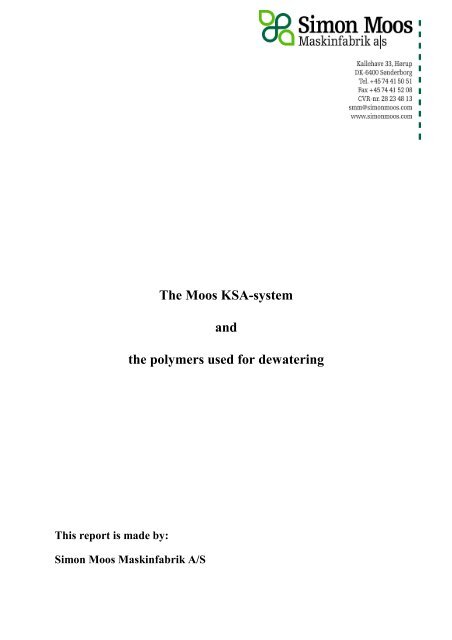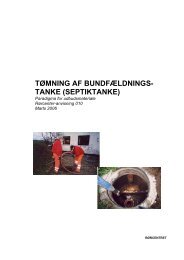The Moos KSA-system and the polymers used for ... - Simon Moos A/S
The Moos KSA-system and the polymers used for ... - Simon Moos A/S
The Moos KSA-system and the polymers used for ... - Simon Moos A/S
Create successful ePaper yourself
Turn your PDF publications into a flip-book with our unique Google optimized e-Paper software.
This report is made by:<br />
<strong>The</strong> <strong>Moos</strong> <strong>KSA</strong>-<strong>system</strong><br />
<strong>and</strong><br />
<strong>the</strong> <strong>polymers</strong> <strong>used</strong> <strong>for</strong> dewatering<br />
<strong>Simon</strong> <strong>Moos</strong> Maskinfabrik A/S
Foreword:<br />
This report has been made <strong>for</strong> explaining <strong>the</strong> <strong>KSA</strong>-<strong>system</strong> more in details <strong>and</strong> <strong>for</strong> focussing on<br />
<strong>the</strong> dewatering of septic sludge with polymer. <strong>The</strong> report deals with toxicity, heavy metals <strong>and</strong><br />
non-environmental substances of polymer.<br />
Conclusion:<br />
<strong>The</strong> use of polymer in dewatering jobs with <strong>the</strong> <strong>KSA</strong>-<strong>system</strong> are no threat to <strong>the</strong> recipient <strong>for</strong> <strong>the</strong><br />
following reasons:<br />
- <strong>The</strong> polymer will not reach <strong>the</strong> recipient because if small polymer residuals remain in <strong>the</strong><br />
reject water <strong>the</strong>y will bind with <strong>the</strong> sludge particles remaining in <strong>the</strong> tank.<br />
- If <strong>the</strong> polymer by an accident should reach <strong>the</strong> recipient <strong>the</strong> polymer will quickly<br />
biodegrade<br />
- <strong>The</strong> adding of heavy metals through polymer is insignificant<br />
- <strong>The</strong> adding of non-environmental substances through polymer is insignificant.<br />
- <strong>The</strong> polymer can not pass biomembranes <strong>and</strong> has <strong>for</strong> that reason no toxicity <strong>for</strong> any living<br />
creatures.
Contents:<br />
3<br />
Page<br />
1. About <strong>the</strong> <strong>KSA</strong> <strong>system</strong>.........................................................................................................1<br />
2. Polymer (polyelectrolytes)...................................................................................................2<br />
References<br />
2.1 In general about polymer ......................................................................................2<br />
2.2 Heavy metals...........................................................................................................3<br />
2.3 Non-environmental substances.............................................................................3<br />
2.4 Toxicity....................................................................................................................4
1. About <strong>the</strong> <strong>KSA</strong> <strong>system</strong><br />
<strong>The</strong> <strong>KSA</strong>-<strong>system</strong> is built in a container which is separated in several rooms of various sizes.<br />
In <strong>the</strong> following <strong>the</strong> <strong>KSA</strong>-<strong>system</strong> is described with a view to <strong>the</strong> processes taking place during<br />
<strong>the</strong> cleaning of <strong>the</strong> water.<br />
- <strong>The</strong> contents of <strong>the</strong> septic tank is sucked into <strong>the</strong> vacuum tank. During this process <strong>the</strong><br />
sludge is homogenized. A fur<strong>the</strong>r homogenizing of <strong>the</strong> sludge can take place in <strong>the</strong><br />
vacuum tank by means of a strong air flow.<br />
- <strong>The</strong> homogenized contents of <strong>the</strong> vacuum tank is pumped into <strong>the</strong> dewatering tank <strong>and</strong><br />
during this process polymer in exact quantities is added. <strong>The</strong> polymer solution (max.<br />
0,5% w/w solution) is stored in <strong>the</strong> polymer tank, which contains a stirring device. <strong>The</strong><br />
quantity of <strong>the</strong> polymer is dosed by means of an adjustable dosing pump. <strong>The</strong> amount of<br />
polymer to be dosed is estimated by means of both visual <strong>and</strong> physical methods made by<br />
a test sample drawn from <strong>the</strong> test cock.<br />
- <strong>The</strong> testing is important because if <strong>the</strong> dosing is too high or too low <strong>the</strong> result of <strong>the</strong><br />
dewatering will be bad. Fur<strong>the</strong>rmore a dosing which is too high will be uneconomical<br />
because of <strong>the</strong> higher consumption of polymer <strong>and</strong> <strong>the</strong> extra cleaning of <strong>the</strong> dewatering<br />
filters.<br />
Polymer <strong>and</strong> sludge is mixed thoroughly resulting in <strong>the</strong> best possible dewatering.<br />
<strong>The</strong> adding of polymer results in coagulation of <strong>the</strong> sludge particles <strong>and</strong> in a separation of<br />
water <strong>and</strong> particles. <strong>The</strong> water runs through <strong>the</strong> dewatering filters (size of <strong>the</strong> mesh is<br />
7ooFm) <strong>and</strong> runs to <strong>the</strong> rejectwater tank. During <strong>the</strong> dewatering process no pressure,<br />
compression or vacuum takes place, <strong>and</strong> because of this <strong>the</strong> rejectwater is extremely clean<br />
in comparison with rejectwater obtained from o<strong>the</strong>r dewatering <strong>system</strong>s.<br />
- <strong>The</strong> septic tank is filled with <strong>the</strong> rejectwater resulting from <strong>the</strong> dewatering process, this<br />
preserves <strong>the</strong> biological activity in <strong>the</strong> septic tank. <strong>The</strong> rejectwater which is going back<br />
originates from <strong>the</strong> septic tank which has just been emptied. If small polymer residues<br />
remains in <strong>the</strong> reject water <strong>the</strong>y will bind with <strong>the</strong> sludge particles always remaining in<br />
<strong>the</strong> septic tank. In this way it is ensured, that <strong>the</strong> polymer will not be let out in <strong>the</strong><br />
receipient.<br />
- After emptying, dewatering <strong>and</strong> returning of <strong>the</strong> cleaned water <strong>the</strong> process can be<br />
repeated with a new septic tank.<br />
- When <strong>the</strong> working day has ended <strong>the</strong> dewatered sludge can be emptied in an approved<br />
depositing place (an approved dump site or an waste water treatment plant)<br />
<strong>The</strong> advantage of <strong>the</strong> <strong>KSA</strong>-<strong>system</strong> is that septic sludge can be treated individually (depending on<br />
<strong>the</strong> condition of <strong>the</strong> sludge) by changing <strong>the</strong> type <strong>and</strong> <strong>the</strong> amount of polymer. <strong>The</strong> <strong>system</strong> will<br />
fur<strong>the</strong>rmore homogenize <strong>the</strong> sludge which makes it easier to dose it with <strong>the</strong> correct amount of<br />
polymer. Fur<strong>the</strong>rmore <strong>the</strong> <strong>system</strong> makes it possible to empty septic tanks all day long without<br />
having to empty <strong>the</strong> <strong>system</strong>. In this way transport time <strong>and</strong> fuel consumption is reduced. All
things considered a very good environmental solution.<br />
2. Polymer (polyelectrolyte)<br />
Polymer is an organic dewatering aid with a high molecular mass, based on polyacrylicamide.<br />
Polymers are in three groups:<br />
a) Nonionic polymer<br />
b) Anionic polymer<br />
c) Cationic polymer<br />
2.1 In general about polymer<br />
<strong>The</strong> charges of <strong>the</strong> <strong>polymers</strong> will bind very strongly to particles with <strong>the</strong> opposite charge. As<br />
<strong>polymers</strong> are long molecule groups a lot of particles will be bound to a polymer molecule. It<br />
results in <strong>the</strong> <strong>for</strong>mation of large colloids (flocs), separating water <strong>and</strong> suspended solids. <strong>The</strong><br />
water which has been separated will now only contain solutions. <strong>The</strong> flocculation does not<br />
happen by means of a chemical reaction, but by means of a physical reaction, where negative<br />
particles attract positive particles <strong>and</strong> vice versa. <strong>The</strong> active polymer is accumulated in <strong>the</strong> sludge<br />
/2/.<br />
Polymers have a high affinity <strong>for</strong> solid surfaces, <strong>and</strong> absorb strongly <strong>and</strong> irreversibly. <strong>The</strong>re<strong>for</strong>, it<br />
is highly unlike that <strong>the</strong>y will pass through a sewage-treatment process, but will be absorbed by<br />
<strong>the</strong> biomass <strong>and</strong> o<strong>the</strong>r suspended matter <strong>and</strong> thus be fully removed from <strong>the</strong> sewage be<strong>for</strong>e<br />
discharge, reporting ultimately in <strong>the</strong> sludge. /1/<br />
Polymers <strong>and</strong> co-<strong>polymers</strong> are stable when pure, but <strong>the</strong>y are quickly biodegradable when mixed<br />
with water.<br />
Nonionic polymer<br />
<strong>The</strong> nonionic <strong>polymers</strong> are molecules with a neutral charge, <strong>the</strong>y usually react with particles<br />
being ei<strong>the</strong>r faintly cationic or faintly anionic. A nonionic polymer is typically <strong>used</strong> <strong>for</strong> sludge of<br />
acid reaction or sludge from <strong>the</strong> paper industry.<br />
Nonionic polymer is technically polyacrylamides with neutral charges. <strong>The</strong> polymer is obtainable<br />
both as granulate <strong>and</strong> as emulsion.<br />
Anionic polymer<br />
<strong>The</strong> anoinic <strong>polymers</strong> are molecules with a negative charge <strong>and</strong> will react with sludge particles<br />
with a positive charge. An anoinic polymer must <strong>the</strong>re<strong>for</strong>e be applied to a sludge type with a<br />
positive charge - typically chemically precipitated sludge <strong>and</strong> industrial sludge.<br />
Anionic <strong>polymers</strong> are co-<strong>polymers</strong> of acrylamide with increasing contents of acrylic groups,<br />
which give <strong>the</strong> <strong>polymers</strong> <strong>the</strong>ir negative charges. <strong>The</strong> polymer is obtainable both as granulate <strong>and</strong><br />
as emulsion-. /9/
Cationic <strong>polymers</strong><br />
<strong>The</strong> cationic <strong>polymers</strong> are molecules with a positive charge <strong>and</strong> will react with sludgeparticles<br />
with a negative charge. A cationic polymer must <strong>the</strong>re<strong>for</strong>e be applied to a sludge type with a<br />
negative charge - typically sludge from septic tanks, <strong>and</strong> from mechanical <strong>and</strong> biological sewagetreatment<br />
plants.<br />
Cationic <strong>polymers</strong> are co-<strong>polymers</strong> of acrylamide with increasing amount of cationic comonomeres.<br />
<strong>The</strong> polymer is obtainable both as granulate <strong>and</strong> as emulsion. /9/<br />
2.2 Heavy metals<br />
Research has both shown certain heavy metals in polyelectrolytes <strong>and</strong> found <strong>the</strong> contents<br />
negligible. <strong>The</strong> adding of heavy metals to <strong>the</strong> sludge through <strong>the</strong> polyelectorlytes is insignificant.<br />
/2//3/.<br />
Research has shown that <strong>the</strong> contents of heavy metals in <strong>the</strong> reject water often are below <strong>the</strong> limit<br />
of detection. <strong>The</strong> very low contents of heavy metals in <strong>the</strong> reject water is a.o. due to:<br />
- <strong>the</strong> very low contents in <strong>the</strong> polymer<br />
- strong adsorption from <strong>the</strong> polymer<br />
- <strong>for</strong>mation of complexes of colloid particles during <strong>the</strong><br />
dewatering /10/<br />
- <strong>the</strong> construction of <strong>the</strong> dewatering tank gives <strong>the</strong> sludge<br />
filtrating characteristics<br />
2.3 Non-environmental substances<br />
<strong>The</strong> contribution to <strong>the</strong> contents of non-environmental organic substances in <strong>the</strong> sludge are<br />
insignificant /2/<br />
On this basis it is likely that <strong>the</strong>re are no substantial environmental problems involved when <strong>the</strong><br />
products in question are applied in sludge dewatering /2/<br />
A unique definition of <strong>the</strong> non-environmental organic substances is difficult, but seen in <strong>the</strong> light<br />
of a similar American list with 192 substances, Sweden <strong>and</strong> Norway have made a list of priority<br />
pollutants, comprising 70 non-environmental substances /4/.<br />
Priority pollutants have been selected both because of <strong>the</strong>ir dangerousness to <strong>the</strong> environment<br />
(toxicity, degradability <strong>and</strong> bio accumulation) <strong>and</strong> from <strong>the</strong> high frequency in use <strong>and</strong> occurence<br />
/4/.<br />
With a dosing of polymer at an average of 2,5 g/kg dry solids <strong>the</strong> polymer will give 0,045 Fg<br />
chlorobenzenes/kg dry solids sludge <strong>and</strong> 0,625 Fg trichlorethane/kg dry solids sludge.
<strong>The</strong> contents of non-environmental substances in <strong>the</strong> reject water will typically be even less than<br />
in <strong>the</strong> dewatered sludge, as <strong>the</strong>se substances are mainly bound to <strong>the</strong> particles in <strong>the</strong> sludge. This<br />
is a.o. due to:<br />
- a very low contents in <strong>the</strong> polymer<br />
- strong adsorption from <strong>the</strong> polymer<br />
- <strong>the</strong> construction of <strong>the</strong> draining tank gives <strong>the</strong> sludge<br />
filtrating characteristics.<br />
2.4 Toxicity<br />
Research (/5/, /6/, /7/, /8/) of polyacrylamide <strong>and</strong> acrylamide with at view to <strong>the</strong> toxicity, biodegradability<br />
etc. shows <strong>the</strong> following:<br />
<strong>The</strong> toxicity of polyacrylamide originates from <strong>the</strong> contents of acrylamide.<br />
<strong>The</strong> researches agree that <strong>the</strong> toxicity of polyacrylate is very low. <strong>The</strong> polymer itself is not toxic<br />
as it cannot pass biomem-branes.<br />
Acrylamide-monomers have a high water solubility <strong>and</strong> are biodegradable in anaerobic or<br />
aerobic, light or dark conditions.<br />
A bio-concentration <strong>and</strong> accumulation of acrylamide in <strong>the</strong> food chain is not likely.<br />
Based on <strong>the</strong> knowledge which has been ga<strong>the</strong>red now, one can conclude that <strong>the</strong>re are no<br />
negative effects on <strong>the</strong> environment due to <strong>the</strong> use of polyelectrolytes in sewage-treatment plants<br />
or by using <strong>the</strong> dewatered sludge on farml<strong>and</strong> /7/.<br />
<strong>The</strong> use of polyelectrolytes in sludge dewatering is unproblematic seen on this basis.
1/ Allied Colloids<br />
Pollution Control Division<br />
"Technical <strong>and</strong> Processing Data <strong>for</strong><br />
Zetag <strong>and</strong> Magnafloc".<br />
/2/ Miljøministeriet Miljøstyrelsen<br />
Miljøprojekt nr. 255.<br />
"Fældningskemikaliers indhold<br />
af miljøfremmede stoffer", 1994<br />
References:<br />
/3/ Metaller i kommunalt avloppavatten.<br />
Rapport NSV PM 1942.<br />
Naturvårdsverket og Svenska Vatten- och Avlopsverks<strong>for</strong>ening, 1985.<br />
/4/ "Slam - Innhåll av organiske miljöfarliga ämnen".<br />
NSV - rapport 4085.<br />
Statens Naturvårdsverk, Sverige,1992<br />
/5/ Acrylamide <strong>and</strong> Polyacrylamide: A Review of Production, Use, Environmental Fate <strong>and</strong><br />
Neurotoxicity.<br />
Eldon A. Smith <strong>and</strong> F,W. Oehme. Kansas State University, USA.<br />
Rev. Environ. Health, Volume 80 - 1989.<br />
/6/ Toxicity of Polyacrylamide <strong>and</strong> Acrylamide Monomer.<br />
Diana J. King, Richard R. Noss.<br />
University of Massachusetts, USA.<br />
Rev. Environ. Health, Volume 80, 1989.<br />
/7/ Auswahl und Einsatz von organischen Flockunsthilfsmitteln - Polyelectrolyten - bei der<br />
Klärschlammentwasserung. Arbejdsrapport fra ATV/BDE/VKSudvalg 3.2.<br />
ATV-Arbeitsberichte, 4/1992.<br />
/8/ Der einfluss von Polymeren auf die anaerobe Schlammfaulung und die Entwasserbarkeit<br />
von Faulschlammmen. Helmut Kapp.<br />
Gwf-wasser/abwasser 126, 1985.<br />
/9/ Hüls: High tech polymer<br />
Hüls Danmark A/S, 01.05.1995<br />
/10/ Kemiske stoffer i l<strong>and</strong>jords miljøer.<br />
Arne Helweg, Teknisk Foelag A/S, 1988




